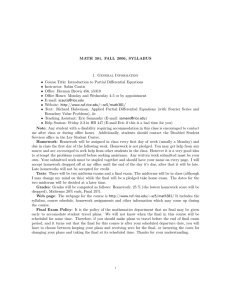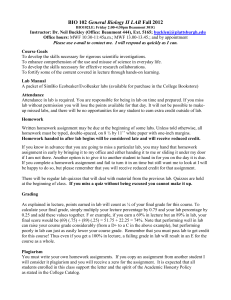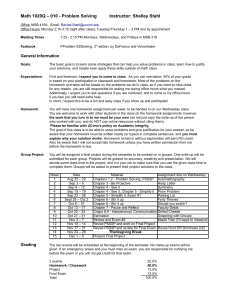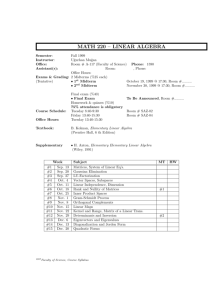AST 248 The Search for Life in the Universe Fall 2014
advertisement
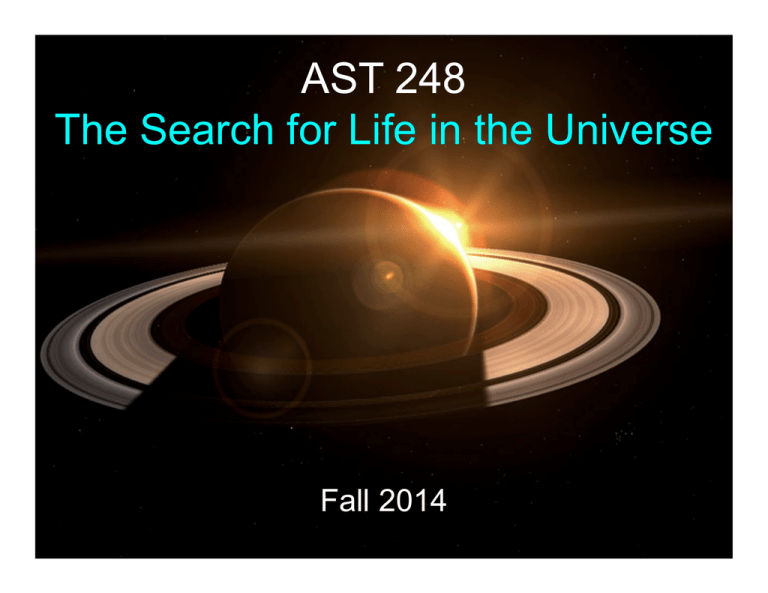
AST 248 The Search for Life in the Universe Fall 2014 "... Are you so stupid to think that just because we're alone here, there's nobody else in this room? Do you consider us so boring or repulsive that of all the millions of beings, imaginary or otherwise, who are prowling around in space looking for a little company, there is not one who might possibly enjoy spending a moment with us? On the contrary my dear -- my house is full of guests..." Jean Giraudoux, The Madwoman of Chaillot Administrative Details • Professor: Frederick M. Walter – ESS 459 – 632-8232 – Frederick.walter@stonybrook.edu – Office hours: MWF 9-10, or by appointment Please put AST248 in the subject line if e-mailing • TA: Ryan Richards • http://www.astro.sunysb.edu/fwalter/AST248 Course Organization • Two lectures weekly – TuTh 1:00-2:20; Harriman 137 • Two in-class midterms (20% each) – Thursday Sept 18 – Thursday Oct 23 • Weekly in-class quizzes (15%) • Term Paper, due Tue Nov 25 (15%) • Final exam Mon Dec 15, 5:30 PM (30%) AST 248 : Syllabus http://www.astro.sunysb.edu/fwalter/AST248/syllabus.html AST 248: Search for Life in the Universe Syllabus Fall 2014 Lecture: Tuesdays and Thursdays,1:00-2:20 PM Room: Harriman 137 Instructor: Prof. Fred Walter (ESS 459; 632-8232; frederick.walter at stonybrook.edu) Office Hours: MWF 9-10AM, or by appointment TA: Ryan Richards Lecture Schedule Week Date Topics Reading 1 Aug 26 Aug 28 Introduction; The Drake Equation You Live Here; What is Science? BS 1, 3, Appendix C 2 Sep 4 N* The Sun The Influence of the Sun on Earth BS 2, 3 3 Sep 9 Sep 11 N* Why the Sun Shines The Stars: Other Suns BS 2, 3, 10.1, 11.1 4 Sep 16 fs The Lives of the Stars BS 2, 3, 10.1, 11.1 4 Sep 18 Midterm 1 BS 1,2,3,10.1,11.1 5 Sep 23 fp Sep 25 N h Overview of the Solar System The Habitable Zone BS 3 6 Sep 30 Oct 2 fl What is Life? The Nature of Biological Evolution The History of The World. Part I. BS 5 7 Oct 7 Oct 9 fl The History of The World. Part II. Looking for Life in all the Wrong Places BS 4,6,7 Barsoom BS 8 8 1 of 2 Oct 14 Oct 16 fs Nh fl 8/25/14 11:55 AM AST 248 : Syllabus http://www.astro.sunysb.edu/fwalter/AST248/syllabus.html 9 Oct 21 fl 9 Oct 23 10 Oct 28 fp Oct 30 N h 11 Nov 4 Nov 6 fl fp Europa and the Icy Moons Titan BS 9 Midterm 2 BS 1-9 Exoplanets What makes a Planet Habitable? BS 11 Rare Earth The Galactic Context BS 9, 10, 11 12 Nov 11 Nov 13 fl SETI BS 12 13 Nov 18 Nov 20 fi Spaceflight Contact BS 12 Lifetimes of Civilizations BS 12,13 Dec 2 Dec 4 The fermi paradox BS 13, Epilogue Dec 15 Final Exam BS 1-13 14 15 fc Nov 25 L/T *** note: this plan is subject to change *** Readings Readings from the textbook should be done BEFORE the lecture. That way the lecture can be used to clarify, and not just introduce, concepts. BS refers to chapters in Bennett & Shostak's Life in the Universe. Return to AST 248 main page 2 of 2 8/25/14 11:55 AM Text Bennett & Shostak, “Life in the Universe”, 3rd edition (required) Earlier editions acceptable, but homework problems are from this edition Ward & Brownlee, “Rare Earth” (suggested) Pickover, “Science of Aliens” (suggested) Expectations • This is a rigorous science course. • We will do quantitative calculations • You are strongly advised to attend lectures • You should expect to put in 6-9 hours outside class, reading the material and doing homework. Scope of Astrobiology • Astronomy (physics) • Biology • Chemistry • Geology and Planetology • Information Theory • Estimation • Psychology/Sociology Goals • Understand why we are interested in the question of life in the universe • Understand the meaning of life, and how it evolves • Understand the requirements for supporting life as we know it • Understand what parts of this field are science, and what are speculation • Understand how to make estimations Learning Objectives A student in this course must be able to – think critically about data, and – synthesize disparate facts to reach a conclusion in almost any area where the data can be quantified. A student mastering this course will understand: – – – – – – – the reasoning behind Drake's equation how to apply estimation techniques in general how the Sun and stars evolve the concept of habitable zones the changing Earth and the evolution of life thereupon the concept of the habitable zone the rationale behind and methods for searching for life elsewhere in the Solar System, and elsewhere in the Galaxy – the Fermi paradox


